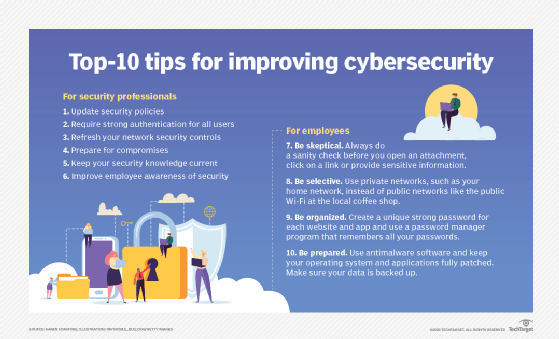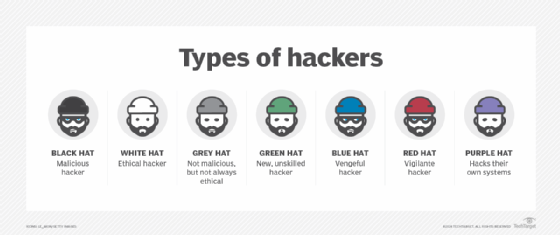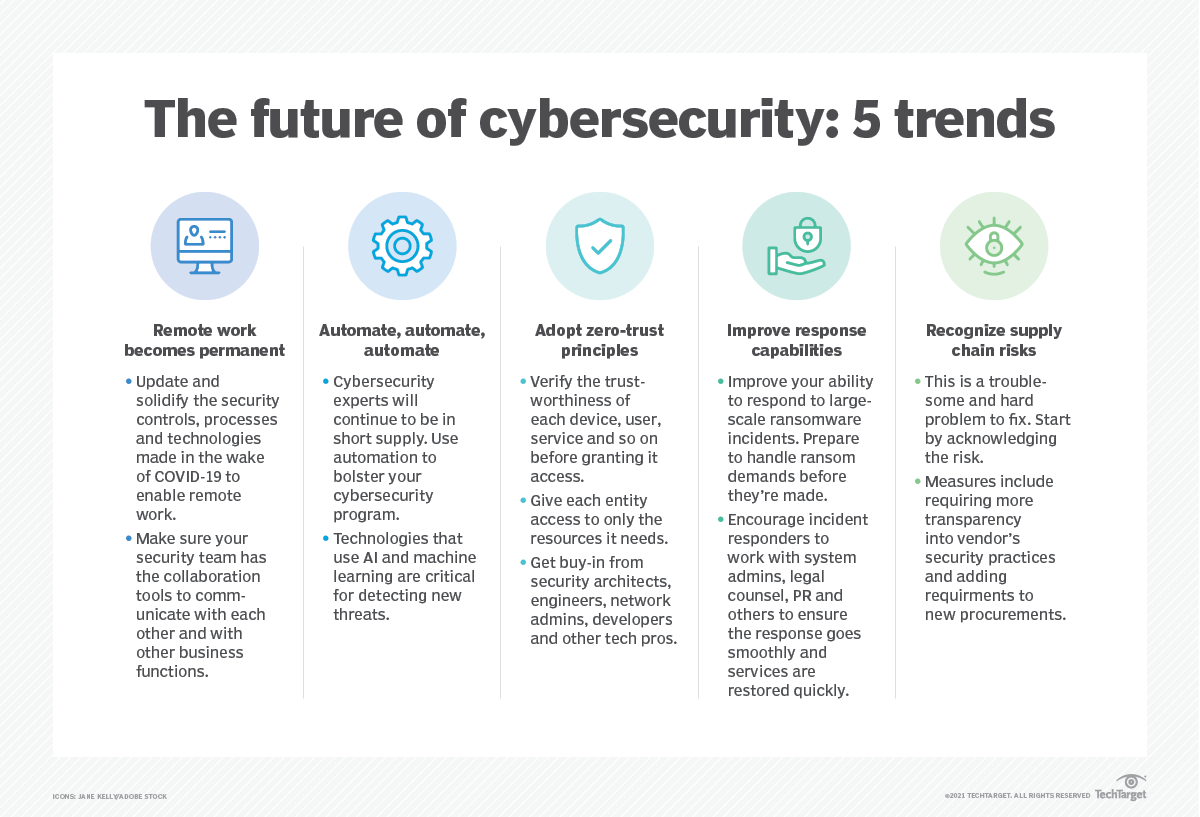What is a hacker?
A hacker is an individual who uses computer, networking or other skills to overcome a technical problem. The term also refers to anyone who uses such abilities to gain unauthorized access to systems or networks for illegal or unethical purposes. A hacker might, for example, steal information to hurt people via identity theft or bring down a system and hold it hostage in order to collect a ransom.
The term hacker has historically been a divisive one, sometimes being used as a term of admiration for individuals who exhibit a high degree of skill and creativity in their approach to technical problems. It was first used in the 1960s to describe a programmer or an individual who, in an era of highly constrained computer capabilities, could increase the efficiency of computer code in a way that removed -- or hacked-- excess machine code instructions from a program. It has evolved over the years to refer to someone with an advanced understanding of computers, networking, programming or hardware.
How does hacking work?
Hackers use technical skills to exploit cybersecurity defenses. Ethical hackers test for cybersecurity vulnerabilities and might take up hacking as a profession -- for example, a penetration tester (pen tester) -- or as a hobby. The end goal is often to gain unauthorized access to computers, networks, computing systems, mobile devices or internet of things systems.
Modern hackers often rely on AI-powered tools to automate attacks and identify vulnerabilities faster, making their efforts more efficient and dangerous. Many professional hackers use their skills to determine security holes in enterprise systems and then advise where companies should boost their security defenses to keep threat actors out. Malicious hackers might steal login credentials, financial information and other types of sensitive information.
Many hackers aim to breach defenses by exploiting either technical or social weaknesses. Technical weaknesses include vulnerabilities in software or other exploitable weak spots. To exploit social weaknesses, hackers attempt to manipulate social outcomes through false pretenses, such as impersonating a co-worker or other individual to gain financial or login information. Hackers might also use their technical skills to install dangerous malware, steal or destroy data or disrupt an organization's services.

Hackers of all types participate in forums to exchange hacking information and tradecraft. There are numerous hacker forums where ethical hackers can discuss or ask questions about hacking. Many of these hacker forums offer technical guides with step-by-step instructions on hacking.
In contrast, forums and marketplaces serving threat actors or criminal hackers are often hosted on the dark web and provide an outlet for offering, trading and soliciting illegal hacking services.
Criminal hackers, who sometimes lack technical skills, often use scripts and other specifically designed software programs to break into corporate networks. This software can manipulate network data to gather intelligence about the target system. These scripts can be found posted on the internet for anyone -- usually entry-level hackers -- to use. Hackers with limited skills are sometimes called script kiddies, referring to their need to use malicious scripts and their inability to create their own code. Advanced malicious hackers might study these scripts and then modify them to develop new methods.
The evolution of hacking
Over the decades, hacking -- which began as a more harmless activity -- has evolved into a sophisticated form of cyber warfare. From the 1960s to the 1980s, hacking began as a way to improve computer efficiency. Early hackers were enthusiasts and innovators who wanted to explore the limits of technology.
With the advent of the internet in the 1990s, hacking shifted from exploration to exploitation. Hackers targeted businesses and individuals, leading to the birth of malware and phishing attacks. Modern-day hacking hacking encompasses everything from ethical penetration testing to state-sponsored cyber warfare. Tools such as ransomware-as-a-service (RaaS) and AI-driven malware have raised the stakes in cybersecurity.
What are the different types of hackers?
In the past, the cybersecurity community informally used references to hat color as a way to identify different types of hackers. A few of these terms have been replaced to reflect cultural changes.

- Ethical hackers or authorized hackers. Previously known as white hat hackers, they strive to operate in the public's best interest rather than to create turmoil. Many ethical hackers who perform pen testing are hired by an organization to attempt to break into that company's networks in order to find and report on security vulnerabilities. Security firms then help their customers mitigate security issues before criminal hackers can exploit them.
- Threat actors or unauthorized hackers. Previously known as black hat hackers, they intentionally gain unauthorized access to networks and systems with malicious intent. This includes stealing data, spreading malware or profiting from ransomware, vandalizing or otherwise damaging systems, often in an attempt to gain notoriety. Threat actors are criminals by definition because they violate laws against accessing systems without authorization, but they might also engage in other illegal activity, including corporate espionage, identity theft and distributed denial-of-service (DDoS) attacks.
- Gray hat hackers. They fall somewhere between ethical hackers and threat actors. While their motives might be more similar to one of those two groups, gray hats are often more likely than ethical hackers to access systems without authorization; at the same time, they are more likely than threat actors to avoid doing unnecessary damage to the systems they hack. Although they aren't typically -- or only -- motivated by money, gray hat hackers might offer to fix vulnerabilities they have discovered through their own unauthorized activities rather than using their knowledge to exploit vulnerabilities for illegal profit.
- Red hat hackers. Also called eagle-eyed or vigilante hackers, they are similar to ethical hackers. Red hat hackers intend to stop unethical attacks by threat actors. Although red hat hackers might have a similar intent to ethical hackers, they differ in methodology: Red hat hackers might use illegal or extreme courses of action. Often, red hat hackers deploy cyberattacks toward the systems of threat actors.
- Blue hat hackers. Also known as vengeful hackers, these actors use hacking as a social weapon, like as a means of revenge against a person, employer or organization. Hackers who post personal and confidential data online to ruin reputations, for example, or attempt to gain unauthorized access to email and social media accounts are classified as blue hats.
- Script kiddies. These amateur, inexperienced hackers attempt to use prewritten scripts in their hacking efforts. Often, these are fledgling hacking enthusiasts who cause little damage.
- Hacktivists. These are organizations of hackers that deploy cyberattacks to affect politically motivated change. The purpose is to bring public attention to something the hacktivist believes might be a violation of ethics or human rights. Hacktivism attacks might attempt to reveal evidence of wrongdoing by publicizing private communications, images or information.
What are common hacking techniques?
While the technological basis of these techniques is constantly evolving to keep up with developments in cybersecurity, the following common hacking techniques remain persistent:
- Phishing. The criminal hacker creates a fraudulent email that appears to come from a legitimate organization or individual and prompts the user to open it. Users are then tricked with phishing into entering their login credentials and disclosing other personal information, such as birth date, Social Security number or credit card details.
- Viruses and malicious code. A hacker inserts malicious code, including worms and Trojan horses, into website files, often with the intent to steal cookies that track a user's online activity.
- User interface (UI) redress. This technique, also known as clickjacking, creates a fake UI and link on top of an authentic webpage and tricks the user into clicking on the link. The threat actor can then take over access to the user's computer without their knowledge.
- DoS and DDoS. These techniques make it impossible for users to access their computer systems, networks, services or other information technology (IT) resources. Typically, a criminal hacker uses this technique to crash web servers, systems or networks by disrupting the normal flow of traffic.
- Domain name system cache poisoning. The technique of DNS cache poisoning, also known as DNS spoofing, exploits DNS clients and web servers by diverting internet traffic to fake servers.
- Structured Query Language injection. This technique adds SQL code to a web form input box in order to gain access to unauthorized resources and data.
- Keylogger injection. A keylogging program is injected into the user's system as malware to monitor and record each of the user's keystrokes. This enables the threat actor to steal personally identifiable information, login credentials and sensitive enterprise data.
- Brute-force attack. These attacks commonly use automated tools to guess various combinations of username and password until they find the correct combination.
Emerging trends in hacking
In addition to the aforementioned types of hacking techniques, a variety of new forms of hacking are emerging today, including the following:
- AI-powered cyberattacks. Hackers use artificial intelligence to develop smarter malware that can evade detection and adapt to security measures in real time.
- Ransomware evolution. RaaS platforms have made it easier for even novice hackers to launch attacks, democratizing cybercrime.
- State-sponsored hacking. Nation-states increasingly employ hackers to conduct cyber espionage, disrupt critical infrastructure and influence political outcomes.
- Quantum computing threats. As quantum computing becomes more accessible, it could render current encryption methods obsolete, which creates new and unprecedented challenges for cybersecurity.
Famous hackers
While many famous technologists have been considered hackers -- including Donald Knuth, Ken Thompson, Vinton Cerf, Steve Jobs and Bill Gates -- threat actors are more likely to gain notoriety as hackers in mainstream accounts. Gates was also caught breaking into corporate systems as a teenager before founding Microsoft.
Some notorious threat actors include the following:
- Anonymous. A group of hackers from around the world who meet on online message boards and social networking forums. They mainly focus their efforts on encouraging civil disobedience and unrest via DoS attacks, publishing victims' personal information online and defacing and defaming websites.
- Jonathan James. James gained notoriety for hacking into multiple websites, including those of the U.S. Department of Defense and National Aeronautics and Space Administration, as well as for stealing software code when he was a teenager. In 2000, James became the first juvenile -- at just 16 years old -- to be incarcerated for computer hacking. He died in 2008 at the age of 25.
- Adrian Lamo. Lamo hacked into the systems of several organizations, including The New York Times, Microsoft and Yahoo, to exploit their security flaws. Lamo was arrested in 2003, convicted in 2004, sentenced to six months of home detention at his parents' home and two years probation, and ordered to pay about $65,000 in restitution.
- Kevin Mitnick. Mitnick was convicted of a number of criminal computer crimes after evading authorities for two and a half years. Once one of the Federal Bureau of Investigation's Most Wanted for hacking into networks of 40 high-profile corporations, Mitnick was arrested in 1993 and served five years in a federal prison. After his release, he founded a cybersecurity firm to help organizations keep their networks safe.
While not all types of hacking are considered malicious, the presence of threat actors necessitates strong cybersecurity defenses for enterprises, especially those dealing with sensitive information. Breaches in security can cause financial loss, as well as irreversible damage to an organization's reputation.
How to protect your organization against hacking
Organizations and individuals can adopt the following measures to protect against hacking:
- Use multifactor authentication for all accounts.
- Regularly update and patch software.
- Invest in robust firewalls and intrusion detection systems.
- Educate employees on recognizing phishing attempts.
- Encrypt sensitive data and back it up regularly.
- Monitor network traffic for unusual activity.

Adopting such strategies can help mitigate the risk of falling victim to cyberattacks and ensure better security in an increasingly digital world.
Exploring different types of data security can help organizations develop a strong security strategy. The increasing commonality of remote work also increases cybersecurity risks, so enterprises must manage cybersecurity accordingly.
To effectively combat cybercrime, companies must understand their attack vectors. Here are the most damaging types of cyberattacks and the preventive measures to implement.





